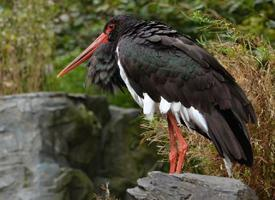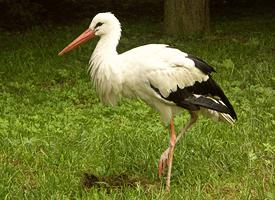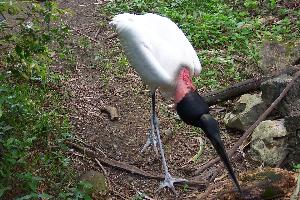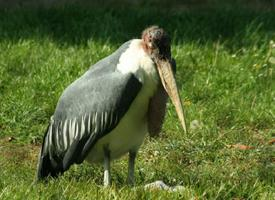
Váhy a míry
| Délka | od 90 do 105 cm |
|---|---|
| Hmotnost | od 2,4 do 3,2 kg |
| Délka rozpětí křídel | od 173 do 205 cm |
Biologická data
| Délka života | 15 r |
|---|
Popis zvířete
The Black Stork (Ciconia nigra) is a large bird, distinctive for its striking coloration and elegance, belonging to the stork family Ciconiidae. This species is somewhat elusive and less known compared to its relative, the white stork, due to its preference for wooded, remote wetland habitats away from human habitation. Adult Black Storks are notable for their glossy black plumage, which covers most of their body, contrasting beautifully with their white belly. They possess long, red legs and a long neck, which is also red, adding to their striking appearance. The beak of the Black Stork is long, pointed, and also red, designed perfectly for foraging in shallow waters.Black Storks are migratory birds, breeding in the warmer months across parts of Europe and Asia, and then migrating to Africa and the Indian subcontinent to escape the cold winter. They prefer to nest in large, tall trees, often choosing secluded areas deep within forests, near freshwater sources like rivers, lakes, or swamps. These nests are substantial structures made of sticks and twigs, lined with grass and leaves, and can be used by the same pair for several years.
The diet of the Black Stork primarily consists of aquatic animals. They feed on fish, amphibians, small reptiles, insects, and occasionally small mammals and birds, which they catch with swift movements of their sharp beak. They forage alone or in pairs, wading through shallow waters, using their keen sight to spot prey.
Black Storks are generally silent, but they are known to make hissing and clattering sounds with their beaks during the breeding season. Courtship displays are elaborate, involving mutual preening, bill-clattering, and neck stretching to strengthen pair bonds.
The breeding season is a critical time for Black Storks. They are solitary nesters, in contrast to the more sociable white storks, which often nest in groups. After courtship, the female lays between 2 to 5 eggs, which are then incubated by both parents for about a month. The chicks are altricial, born blind and featherless, and require significant parental care. Both parents feed the chicks by regurgitating food. The young fledge after about two months but may remain dependent on their parents for a short period thereafter.
Conservation efforts are crucial for the Black Stork, as its habitat is threatened by deforestation, pollution, and wetland drainage. While the species is not currently considered endangered, its preference for secluded habitats makes it vulnerable to the loss of these areas. Conservation programs focus on protecting natural habitats, regulating forestry practices, and ensuring water quality in wetlands to support the diverse aquatic life that Black Storks rely on for food.
In summary, the Black Stork is a magnificent and elusive bird, characterized by its striking coloration, solitary nature, and specific habitat preferences. Despite facing challenges from habitat loss and environmental changes, it continues to thrive in remote parts of its range, embodying the wild and untouched beauty of the natural world.
Podobná zvířata
Nové fotografie zvířat
Top 10 zvířat
- Common cockchafer (Melolontha melolontha)
- Common house mosquito (Culex pipiens)
- Colossal squid (Mesonychoteuthis hamiltoni)
- Hooded merganser (Lophodytes cucullatus)
- Australian box jelly (Chironex fleckeri)
- Fruit fly (Drosophila melanogaster)
- Common reed warbler (Acrocephalus scirpaceus)
- Elephant hawk moth (Deilephila elpenor)
- Diana monkey (Cercopithecus diana)
- Moustached guenon (Cercopithecus cephus)


